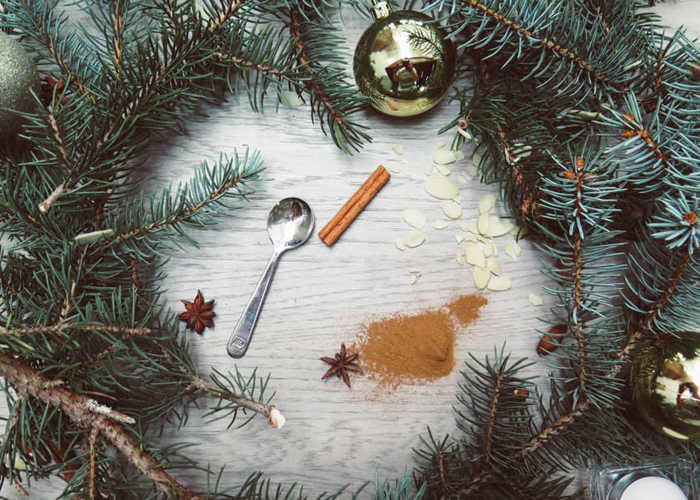You haven’t experienced Christmas lights until you’ve seen nearly four miles of them artfully hung in patterns dictated by Tiffany’s head designer in Copenhagen’s famed historic amusement park, Tivoli Gardens—and that’s not counting the 1,800 strands dramatically draped on the lakeside willows. Copenhagen celebrates Jul (as in “yuletide”) in high style, with its famed Christmas market the centerpiece. Stalls stocked with fine handmade crafts, including traditional figurines of clog-clad elves in pointy red caps, compete for space with vendors selling iced doughnuts slathered with black currant jam and hefty cups of gløgg, a steaming hot mulled red wine laden with raisins, almonds, cinnamon sticks, and cloves—all of which, for good measure, are steeped in aquavit or schnapps.
Christmas in Europe is a time for elaborate pastries straight out of a medieval cookbook, for lyrical midnight masses in Gothic churches, and for the upholding of quirky local traditions—in many countries, Christmas just isn’t complete without mischievous pixies (Copenhagen), kindly witches (Rome), treacherous demons (Salzburg), or an 8,000-pound fruitcake (Dresden). However else Europeans celebrate the Yuletide season, Christmas still centers around an Advent market that, in most cases, has filled the square before the cathedral each December for hundreds upon hundreds of years. Many markets start on the Friday before Advent, which is four Sundays before Christmas Eve; most end on December 24, especially in Germanic countries, where Christmas Eve is set aside for trimming the tree at home. Others keep celebrating until Epiphany on January 6.
Brussels, Belgium
Brussels’ Christmas market has been around only since 2002, but it pulls off its Plaisirs d’Hiver/Winter Pret(“Pleasures of Winter”) festival with elegant style. The theatrics include a nightly sound-and-light show on the Grand Place and a market surrounding the Bourse (Stock Exchange) and along Place Sainte Catherine. In keeping with that Belgian spirit of a United Europe, the 200+ wooden chalets host artisans from around the world hawking a kaleidoscope of Christmas wares, handmade crafts, and souvenirs. Not that Belgian traditions are left out; browse the many food stalls for pots of moules(mussels) and caricoles (peppery whelks or winkles), Belgian fries and fluffy Belgian waffles, seasonal croustillons (sugar doughnuts), and Belgium’s two most welcome additions to world cuisine: fine chocolates and powerful beer. At one end of the shopping, near the fish market, you’ll find a spinning, glittering 160-foot Ferris wheel, and, at the Place de la Monnaie, a nearly 8,000-square-foot ice skating rink.
Copenhagen, Denmark
Copenhagen celebrates Jul (as in “yuletide”) with a Christmas crafts market and surfeit of light-bedecked Christmas trees in the city’s famed historic amusement park, Tivoli Gardens. Nearly four miles of lights are artfully hung in patterns dictated by Tiffany’s head designer, while hundres of strands are draped on the lakeside willows. Join the Danes in warding off the cold with æbleskiver(iced doughnuts with black currant jam) and glogg, a steaming hot mulled red wine laden with raisins, almonds, cinnamon sticks, and cloves—all of which are steeped in aquavit or schnapps. There’s also a crafts market installed along a canal in the historic Nyhavn district; try to visit it between 5 and 6pm weekdays to catch the town crier.
London, England
London’s Christmas shopping season opens in November, when Regent Street ceremoniously switches on its Christmas lights for a pedestrian parade. London typically spreads out its Christmas cheer, from the official Norwegian spruce on Trafalgar Square to the ice skating rink at Somerset House. Trees bedecked with fairy lights herald Hyde Park’s Winter Wonderland (mid-Nov. – early Jan.), which includes London’s largest outdoor skating rink, a toboggan slide, a Ferris wheel, carolers, and a traditional German Christmas market. More small markets spring up at the Natural History Museum, which installs a temporary ice rink (early Nov. -mid-Jan.); and the Greenwich Market (most of Dec.). Christmas concerts abound, but it’s hard to resist the carol sing-along at the Royal Albert Hall (from mid Dec.).
Nuremberg, Germany
On the Friday before Advent, the golden Christmas Angel appears on the high gallery of the medieval Frauenkirche to recite the opening prologue for one of the biggest and most famous Christmas markets of them all. Some two million shoppers descend upon the 180+ candy cane-striped stalls that fill the main square with crafts, ornaments, and toys. The air is perfumed with gingerbread, glühwein, and smoke swirling from bratwurst grills. Market officials enforce traditions with typical Teutonic efficiency: no plastic wreaths, recorded Christmas Muzak, or gaudy carousels allowed.
Prague, Czech Republic
The two best Vanocni trh (Christmas markets) are on the long slope of Wenceslas Square and in the medieval movie set of the Old Town Square formed around a giant Christmas tree, manger scene, and small petting zoo. The markets’ brightly decorated stalls sell wooden toys, Bohemian crystal, handmade jewelry, classic Czech marionettes, and plenty of potential for tooth decay: honeyed gingerbread, vánocvka (a braided pastry studded with raisins), and vosí hnízda’ (“wasps nests,” nutty cookies heavy with rum). Wash it all down with mead and svarene vino (a sweet mulled wine). Christmas Eve dinner consists of wine sausages and carp—you’ll see barrels of the fish everywhere. FYI: Slip a carp scale into your wallet to ensure an adequate cash flow for the upcoming year.
Rome, Italy
Romans erect elaborate presepi (Nativity scenes) across the city, from life-size tableaux on the Spanish Steps and before St. Peter’s to countless crèches in church chapels, all populated by papier-mâché or terracotta figurines and most with a pizza parlor tucked between the shops of the Bethlehem backdrop. Market action centers in Rome on Piazza Navona, its Bernini fountains surrounded by stalls hawking toys, handmade presepio figures, carnival games of chance, ciambelle (dinner plate-size doughnuts), and 101 variations on peanut brittle.
Salzburg, Austria
Salzburg’s Christkindlmarkt is one of Europe’s oldest markets; there are documents from the 15th century describing the fine crafts being sold by elderly women in front of the Salzburg cathedral during Advent season. It is also smaller and more intimate than the others listed here—with under 100 stalls ranged under the floodlit baroque stage set that is downtown Salzburg, with its fountains snuggled under avant-garde glass casings for the winter, church bells echoing off the buildings, and the medieval castle glowering down from the cliff above. It’s a perfect postcard backdrop for browsing stalls selling pewter crafts, furry slippers, and loden coats while keeping warm with Lebkuchen (gingerbread), roasted chestnuts and almonds, sausages, and sweet mulled wine.
Strasbourg, France
The France/Germany border has spent centuries dancing to either side of the Alsace region. It’s currently in the France column, but its Teutonic traditions have blessed the Alsatian capital of Strasbourg with the oldest (445 years and counting) and best Christmas market in France, complete with caroling choirs, Nativity plays, an ice rink, and mulled wine served in boot-shaped mugs. Christkindelsmärik wooden stalls stacked with delicate ornaments and Nativity figurines surround Notre-Dame Cathedral and line Place Broglie. Edible specialties include pretzels, roasted chestnuts, bredele cookies, and Flammekeuche (a “flamed cake” thin pizza of bacon, onions, and crème fraîche).





